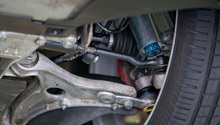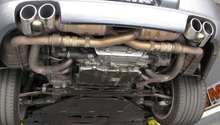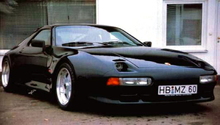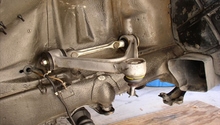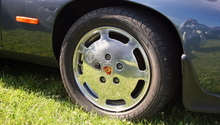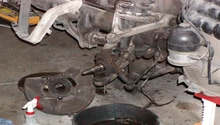Porsche 993: Why is My Car Vibrating?
A car that has developed a vibration can be a worrisome problem. With a little probing of the tires, steering, suspension, brakes, and drive axles, diagnosing the source of the vibration is the first step to correcting the problem. This article will help you pinpoint the cause of the vibration on your Porsche 993.
This article applies to the Porsche 993 (1994-1998).
It can be a bit unnerving when you are out for an enjoyable drive in your Porsche 993, and begin to notice a vibration. Vibrations can develop during a variety of driving situations. Some appear only at a certain speeds, while others are always present. Certain vibrations can also be felt through the steering wheel, brake pedal, or seat of the pants. It is important to take note of when your Porsche 993 is experiencing a vibration as it can help you diagnose the problem. This article will examine common causes of a vibration in the Porsche 993, and when they typically occur.

Materials Needed
- Floor jack and jack stands
- Pry bar
- A helpful friend
Step 1 – Check tires and wheels
Tires and wheels are the number one cause of a vibration in a car. With the tires being the only part of the car in contact with the road, an issue with the tire or wheel can be very noticeable at a variety of speeds. There are several tire and wheel issues that can arise, causing a vibration.
- Unbalanced Tire/Wheel: More often than not, a vibration will occur because one or more wheels are not correctly balanced. A balance issue will typically be fine at slower speeds; however, they can become apparent at 50+ mph. It is not uncommon to occasionally need the wheels re-balanced as the tires wear. Similarly, losing a balance weight as small as 1/4 ounce can produce a vibration.
- Bent Wheel: Much like an unbalanced wheel, a bent wheel will also produce a vibration. A bent wheel is especially common in areas that have rough roads with potholes, and raised manhole covers. Typically, the inner rim of the wheel will slightly bend from an impact, which can make the wheel roll slightly out-of-round. This can be checked at home by simply jacking up the car, and spinning the wheel. Any deviation in the rim will indicate that it is bent.
- Flat-Spotted Tire: Softer compound tires, especially modern high performance summer tires, can experience flat-spotting if sitting for an extended period of time. If the car is sitting stationary, all the weight rests on the same spot of each tire and can flatten it, causing out-of-round tires. A car resting for a period as short as a week can also cause minor flat-spotting. However, many tires can recover their shape by simply driving the car. Typically, if a tire has become slightly flat-spotted, it should recover within 10 to 15 miles of regular driving and the vibration should disappear. If the problem persists, the tires are most likely permanently flat-spotted and should be replaced.
- Defective Tire: Finally, it is not uncommon to end up with a tire that goes bad internally, causing a balance issue. Some owners have reported internal tread separation, and quality control issues that have affected seemingly new tires. Most of the time, these will be covered under warranty.
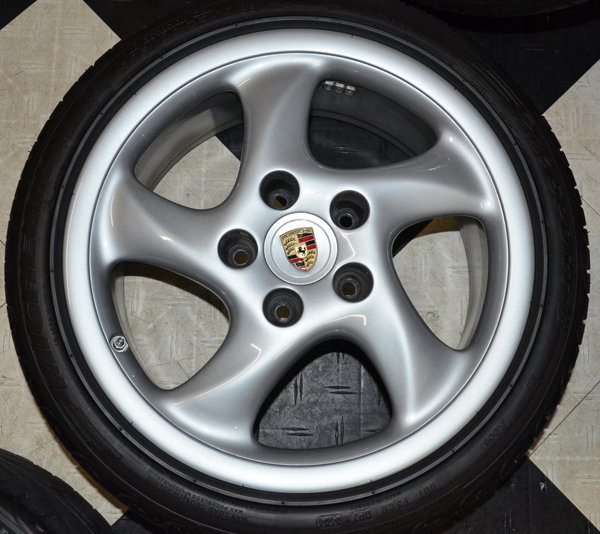
Pro Tip
It is recommended to use a tire shop with reputable equipment capable of balancing hub centric wheels, which is fitted on various Porsche models. Also, Porsche recommends that any tire over six years of age, regardless of condition, should be replaced.
Step 2 – Check control arm bushings
The rubber control arm bushings in the 993 have been known to fail, and cause the car to develop a vibration in the steering or, often times, a general feeling of being "loose." The play in these rubber bushing can be inspected with the car on a lift, or supported by jack stands. Using a small pry bar, apply pressure between the control arm and its mount, while inspecting the condition of the bushing. Cracking in the bushings or excessive play indicates the need for replacement bushings.

Figure 2. Front control arm bushings. 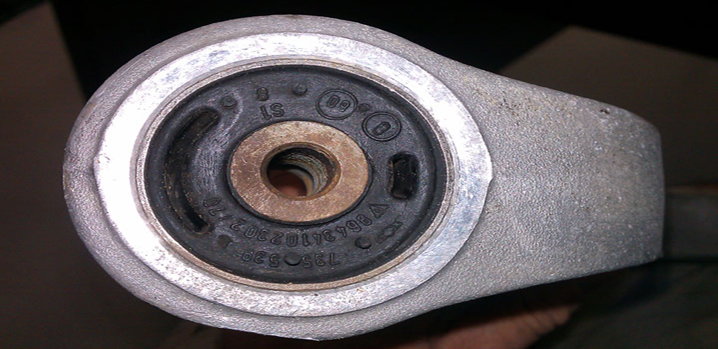
Figure 3. Close-up of factory rubber bushing.
Pro Tip
Factory bushings have failed on some 993s as early as 30,000 miles. It is not a bad idea to also check the bushings in rear suspension because they are of the same rubber-mounted design.
Step 3 – Check tie rods
An intermittent vibration or shimmy in the steering wheel of the 993, especially while turning, can be an indication of a bad tie rod or tie rod end. The tie rods connect the steering rack to the wheel carrier assembly, and turn the wheels when the steering wheel is turned. The tie rod uses an outer sleeve over a rubber bushing that the ball joint is connected to (Figure 4). This is the component that is most likely to fail on the tie rod; however, it is best to check both ends of the tie rods when inspecting them for play. To inspect the tie rods, have the vehicle supported by jack stands, and have a a friend grab the front tire at 9 and 3 o'clock. While feeling the tie rods, have your friend rock the tire forward and back as if the car is turning. If there is any noticeable play, replace the tie rods.
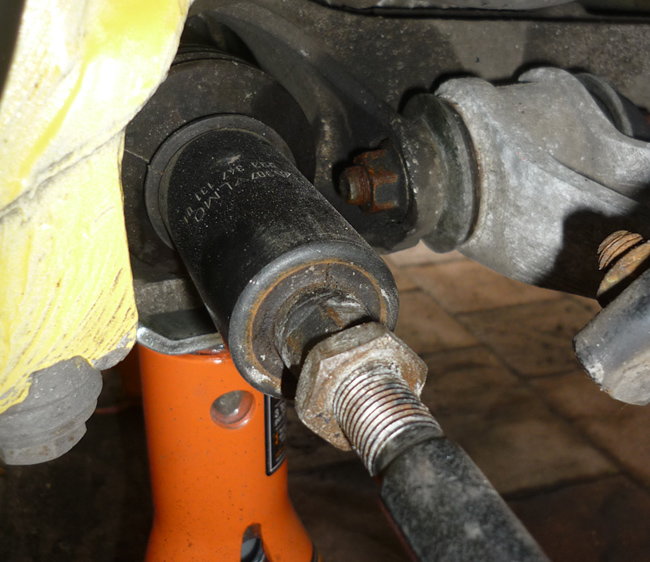
Figure 4. Tie rod inspection at inner ball joint. 
Figure 5. Outer (aftermarket) tie rod end and ball joint.
Pro Tip
While the tie rod end may be the culprit, Porsche only sells a complete tie rod as a replacement.
(Related Article: How to Replace Tie Rod Ends - Rennlist.com)
Step 4 – Check brakes
If you are feeling a pulsation in the brake pedal or a vibration when trying to stop, this points to a problem in the brake system. While it is not very common for Porsche brake rotors to warp, uneven pad deposits on the rotor can give the same feeling of a pulsation or vibration as a warped rotor. Similarly, owners who wash their car and leave it parked afterwards can experience the pads rusting to the rotor. Either of these situations will create an area of the rotor with a higher coefficient of friction, and cause the brakes to grab more when they are at a certain part of the rotor. This can usually be remedied by making a few high speed (50 to 60mph) stops with considerable braking force to clean the rotor. Owners have also solved this issue by installing a new set of brake pads, and bedding them in properly. If this does not solve the issue, the rotors can be measured for excessive run-out to determine if they are indeed warped and in need of a replacement.

(Related Article: How to Replace Brake Pads/Calipers/Rotors - Rennlist.com)
Step 5 – Check CV Joints
The axles running from the transmission to each rear wheel utilizes Constant-Velocity or "CV" joints. These joints are sealed by rubber boots to keep lubrication in and contaminants out. The boots can crack or tear with age, and allow in contaminants that will prematurely wear out the CV joint. Owners have reported that a bad inner CV joint (near the transmission) will cause a constant vibration in the car, which can be felt in the seat of the pants. Also, a continuous clicking noise while traveling down the road is usually an indication of a bad CV joint. Inspect both the inner an outer boots to ensure they are in good condition. You can inspect the axles and CV joints with the car on jack stands. You want to slide the axle in and out to check for clicking or looseness. Also, grab the axle next to the boot, and try to move it in a circle. It should be firm. If it is making noise or moves excessively, the CV joint is worn.
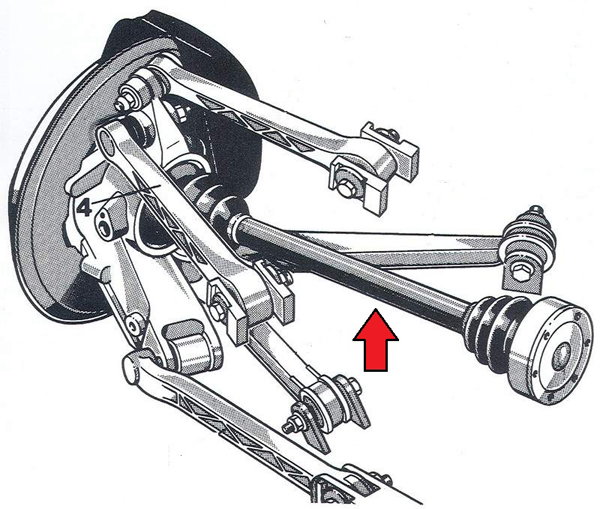
Featured Video: Porsche 993 Bad Driveshaft/CV Joints
Pro Tip
If replacing the CV joint or axle, it is recommended to replace the wheel bearing at the same time.
Step 6 – Check suspension components
It is always a good idea to occasionally check the tightness on all steering and suspension components. This is especially true if new parts were recently installed, or an alignment was completed. Any excessive play in the steering or suspension can cause poor handling, excessive tire wear, and intermittent vibrations.

Related Discussions
- Steering Wheel Vibrates > 60 mph - Rennlist.com
- 964/993 Control Arm Bushings - Rennlist.com
- Warped Rotors?- Rennlist.com

